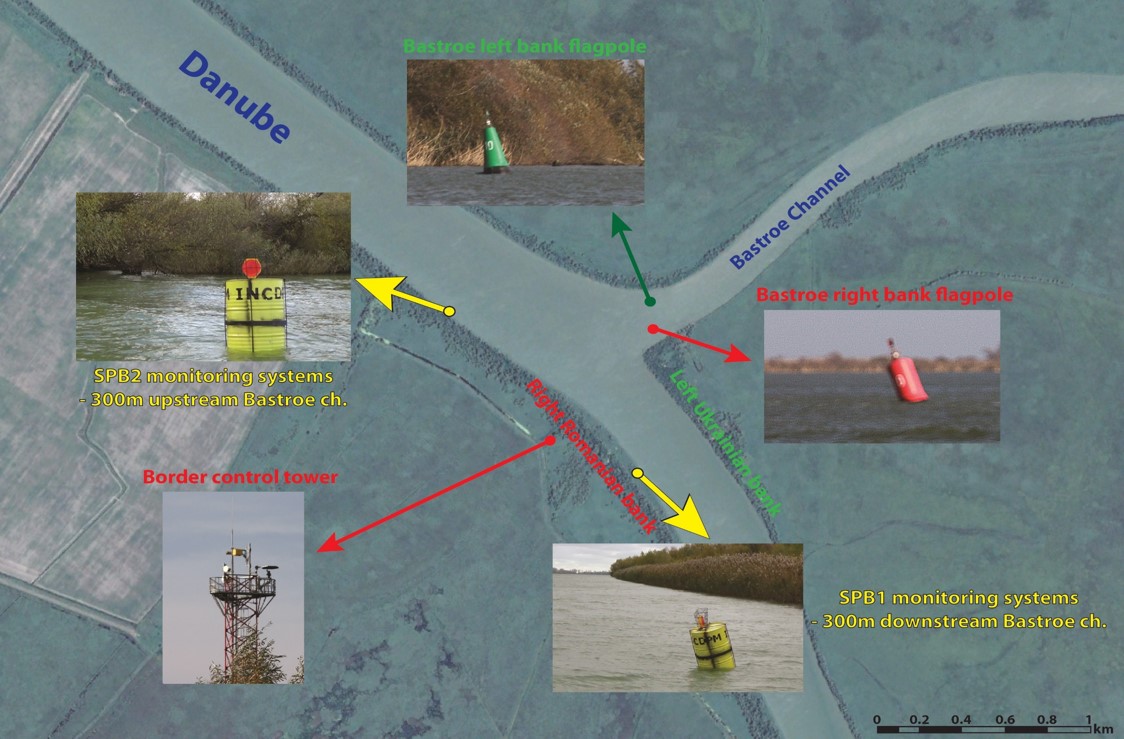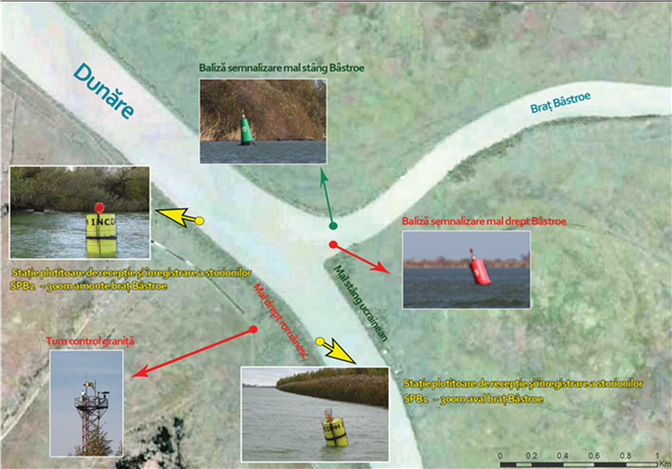- Home
- About Us
- Scientific Departments
- Laboratories Department
- Environmental Quality Assessment
- Waste Management
- Natural and Technological Hazards
- Numerical Modeling And Geographic Information Systems
- Impact of Built Environment and Nanomaterials
- Engineering For Environmental Protection And Impact Assessment
- Climate Change And Sustainable Development
- Biodiversity And Ecosystem Dynamics Department
- Management Of Natural Resources And Green Energy
- Research activity
- Projects
- Reports
- News
- Contact
Study regarding the updating of the physical-chemical and biological components evaluation from Danube Delta and the adjacent coastline considering the transboundary impact of the Bastroe channel and establishing a transboundary monitoring system coordinated together with the Ukrainian part, in order to analyze the environmental impact on the Danube Delta Biosphere Reserve of the project regarding the construction of the deep sea navigation channel on the Bastroe branch (2014)
In 2004, Ukraine decided to execute the first phase of the deep sea channel construction on Chilia and Bâstroe branches without notifying Romania, considering that the project had no cross-border effects. Between 2005-2006, the Investigation Commission identified several transboundary effects such as: dredging works together with the increasing of sediment concentration, downstream of dredging areas, which will affect the hydrology and fish habitats; the discharge of sediments in the sea will affect the Romanian coastal area; and also both traffic intensification and habitats losing will produce large-scale and long-term cumulative effect on birds and fish. Additionally, the Commission highlighted that these effects are available also for the second phase of the Ukrainian channel execution and subsequently in the exploitation period.
In 2013, during the Mixed Trilateral Romania – Moldova – Ukraine Commission meeting, these countries approached the issue regarding the impact of the Ukrainian project on the Danube Delta. Therefore some measures have been decided in order to improve the cooperation on this issue, particularly regarding the transfer of studies and data collected during the post – project monitoring, joint analysis of these studies as well as joint monitoring in the Danube Delta. Thus, in 2013 a ”Study regarding the quality monitoring of the physical-chemical and biological components from Danube Delta and the adjacent coastline considering the transboundary impact of the Bastroe channel, during 2010-present, and the environment consequences analysis in the Danube Delta Biosphere Reservation and the adjacent coastline determined by the Bastroe Project” was achieved.
Considering the necessity to present the Romanian monitoring results regarding the impact of the deep-sea navigation channel on the Bastroe branch during the trilateral Romania-Ukraine-Republic of Moldova meeting, it was necessary to update the data with new information obtained up to 2014 by the institutes and authorities responsible for the management and protection of environmental factors in the Danube Delta.
In this respect, the project targeted :
Considering the necessity to present the Romanian monitoring results regarding the impact of the deep-sea navigation channel on the Bastroe branch during the trilateral Romania-Ukraine-Republic of Moldova meeting, it was necessary to update the data with new information obtained up to 2014 by the institutes and authorities responsible for the management and protection of environmental factors in the Danube Delta.
In this respect, the project targeted :
- Updating and completing with data on the state of the physical-chemical and biological components in the Danube Delta and the adjacent coastal area (water, hydrobiology, fish, birds, amphibians, reptiles and mammals).
- Analysis of the environmental consequences in the Danube Delta Biosphere Reserve and the adjacent coastal area, based on data and information determined by the Bâstroe project – a special attention being paid to fish (sturgeons), birds and to the hydro-morphological elements.
- Elaboration of an updated proposal regarding the Romanian-Ukrainian joint transboundary monitoring system in order to assess the environmental impact of the deep-sea Danube-Black Sea channel, built on the Bastroe branch.
- Partners
National Institute for Research and Development in Environmental Protection (INCDPM)
“Danube Delta” National Institute for Research and Development (INCDDD)
National Institute for Marine Research and Development “Grigore Antipa” (I.N.C.D.M. “Grigore Antipa” Constanţa)
National Institute of Hydrology and Water Management (INHGA) - Project Director:
Eng. Deák György PhD. habil
- Period
25.11.2014 – 15.12.2014 - Financed via
Ministry of Environment and Climate Changes
Obiectives
The main project objective involves updating the data regarding the evaluation of the physical-chemical and biological components from the Danube Delta and the adjacent coastal area in the context of transboundary impact of Bastroe Channel and establishing a cross-border monitoring system in cooperation with the Ukrainian authorities in order to analyze the impact of the deep sea navigation channel, constructed on the Bastroe branch
Results
In order to analyze and confirm the sturgeons migration routes, in 2013 the researchers from the National Institute for Research and Development in Environmental Protection installed two monitoring systems on Chilia branch, at the confluence with Bastroe branch (upstream and downstream of it) additional to the two systems installed in 2011 in Isaccea and Tulcea.

Monitoring systems installed on the Chilia branch
Thus, during the period 2011 – 2014, the researchers of INCDPM Bucharest tagged and monitored during the reproduction migration on the Lower Danube over 250 specimens of sturgeons from the 4 species present on our territory: beluga, stellate, starlet and Russian sturgeons. From de figure presented below can be observed that the Russian sturgeons represents only 1% of the total, situation which requires the identification and application of rapid solutions which will lead to an increase of the population level for this species, otherwise existing the risk that in the near future it will disappear from the Danube area.

Captures recorded during the period 2011-2014
The results of a detailed analysis for 2012-2014 period showed that in 2013, during the autumn period, 69% of all sturgeons descend to the sea used the Tulcea branch, while at the end of the spring migration in 2014 the proportion of specimens which descended to the sea on the Chilia branch was the same as in 2012, namely 53%.
The identified solution regarding the intensification of sturgeon routes monitoring by installing some additional stations upstream – downstream from the Bastroe channel led to an increase of the confidence level regarding the information on the sturgeons’ behavior during their migration.
The research has shown that the sturgeons use as migration routes to the Black Sea the Chilia and Old Stambul branches. In this situation, if the Chilia branch becomes an inert zone related to the possibility of sturgeons migration, in conjunction with the situation encountered on the Sulina branch, the only possibility for the migration of these species, protected under the Convention on International Trade in Endangered Species of Wild Fauna and Flora (CITES), will remain St. George branch, thus presenting a major risk of reducing the possibility for sturgeons migration.
În anul 2004, Ucraina a luat decizia executării fazei I a construcţiei canalului navigabil de mare adâncime pe braţele Chilia şi Bâstroe fără notificarea României, considerând că proiectul nu are implicaţii cu caracter transfrontalier. În anul 2005-2006 Comisia de Anchetă a identificat mai multe efecte cu caracter transfrontalier (ex. lucrările de dragaj împreună cu creşterea concentraţiei de sedimente în aval de zonele de dragaj vor afecta hidrologia zonei și habitatele pentru peşti, descărcarea sedimentelor în mare va afecta zona litorală românească, intensificarea traficului şi pierderea habitatelor va produce un efect cumulat la scară mare şi pe termen lung asupra păsărilor şi peştilor) subliniind totodată că acestea sunt valabile şi pentru faza a II-a a execuţiei canalului ucrainean, precum şi ulterior, în perioada de exploatare.
În cadrul reuniunii Comisiei Mixte Trilaterale România – Moldova – Ucraina din anul 2013 aceste țări au abordat și problematica impactului proiectului ucrainean asupra Deltei Dunării. Drept urmare s-a convenit asupra unor măsuri de îmbunătățire a cooperării pe această problemă, în special asupra schimbului de studii și date privind efectuarea monitorizării post – proiect, analiza comună a acestor studii, precum și monitorizarea comună în zona Deltei Dunării. Astfel, în anul 2013 a fost realizat un “Studiu privind monitoringul calităţii componentelor fizico-chimice şi biologice din Delta Dunării şi zona costieră adiacentă în contextul impactului transfrontalier al canalului Bâstroe, pe perioada 2010 – prezent, şi analiza consecinţelor asupra mediului în Rezervaţia Biosferei Delta Dunării şi zona costieră adiacentă determinate de proiectul Bâstroe”. Având în vederea necesitatea prezentări concluziilor monitorizării părţii române în ceea ce priveşte impactul realizării canalului de navigaţie de mare adâncime Dunăre-Marea Neagră pe braţul Bâstroe cu ocazia întâlnirii trilaterale România-Ucraina-Republica Moldova, a fost necesară o reactualizare a datelor cu informaţii noi produse în anul 2014, la nivelul institutelor şi autorităţilor responsabile de managementul şi protecţia elementelor de mediu în Delta Dunării.
În acest sens proiectul a vizat:
În acest sens proiectul a vizat:
- Reactualizarea şi completarea datelor privind starea componentelor fizico-chimice şi biologice din Delta Dunării şi zona costieră adiacentă (apa, hidrobiologia, peştii, păsările, amfibienii, reptilele şi mamiferele).
- Analiza, pe baza datelor şi informaţiilor, a consecinţelor asupra mediului în Rezervaţia Biosferei Delta Dunării şi zona costieră adiacentă, determinate de realizarea proiectului Bâstroe – o atenţie specială acordată peştilor (sturionii), păsărilor şi elementelor hidromorfologice.
- Elaborarea unei propuneri reactualizate privind sistemul comun româno-ucrainean de monitoring transfrontier pentru evaluarea impactului de mediu a proiectului canalului de mare adâncime Dunăre-Marea Neagră pe braţul Bâstroe
- Parteneri
Institutul Național de Cercetare – Dezvoltare pentru Protecția Mediului
Institutul Naţional de Cercetare – Dezvoltare “Delta Dunării”
Institutul Naţional de Cercetare – Dezvoltare Marină “Grigore Antipa”
Institutul Naţional de Hidrologie și Gospodărire a Apelor - Responsabili de Proiect:
Dr. Ing. Habil. Deák György
- Perioada de desfășurare
25.11.2014 – 15.12.2014 - Finanțat prin
Ministerul Mediului si Schimbarilor Climatice
Obiective
Obiectivul general al proiectului presupune reactualizarea evaluării componentelor fizico-chimice și biologice din Delta Dunării și zona costieră adiacentă în contextul impactului transfrontalier al canalului Bâstroe și stabilirea unui sistem de monitorizare transfrontalier, coordonat cu partea ucraineană, în vederea analizării impactului asupra mediului în Rezervația Biosferei Delta Dunării datorat constucției canalului de navigație de mare adâncime pe brațul Bâstroe.
Rezultate
În scopul analizei și confirmării unor rute de migrație ale sturionilor, în anul 2013 cercetătorii Insitutului Național de Cercetare-Dezvoltare pentru Protecția Mediului au montat două sisteme de monitorizare pe brațul Chilia, la confluența cu brațul Bâstroe (amonte și aval de acesta) suplimentar față de alte două sisteme montate în anul 2011 la Isaccea și Tulcea.

Sisteme de monitorizare fixate pe brațul Chilia
Astfel, în perioada 2011 – 2014 cercetătorii INCDPM București au marcat și monitorizat în timpul migrațiilor de reproducere pe Dunărea Inferioară peste 250 de exemplare de sturioni din cele 4 specii prezente pe teritoriul țării noastre: morun, nisetru, păstrugă și cegă. Din graficul prezentat mai jos se observă faptul că nisetrul constituie un procent de doar 1% din total, ceea ce impune găsirea și aplicarea rapidă a unor soluții care să ducă la creșterea nivelului populațional al acestei specii, existând altfel riscul ca în viitorul apropiat să dispară din arealul Dunării.

Capturi înregistrate în perioada 2011-2014
Rezultatele unei analize amănunțite a perioadei 2012-2014 au arătat că în anul 2013 în perioada de toamnă, un procent de 69% din totalul sturionilor coborâți spre mare au folosit brațul Tulcea, în timp ce proporția exemplarelor care au coborât către mare pe brațul Chilia la sfârșitul migrației de primăvară 2014 este aceeași cu cea din 2012 și anume 53% .
Soluţia de intensificare a monitorizării traseelor sturionilor prin montarea unor staţii suplimentare aval-amonte de Bâstroe a dat rezultate ducând la creşterea nivelul de încredere al volumului informaţional referitor la comportamentul sturionilor pe perioada lor de migrare. Cercetările au evidențiat faptul că sturionii folosesc ca trasee de migrare braţul Chilia şi Stambulul Vechi, spre şi dinspre Marea Neagră. În acestă situaţie, în cazul în care şi braţul Chilia devine o zonă inertă vis-a-vis de posibilitatea de migrare a sturionilor, coroborat cu situaţia de la braţul Sulina, singura posibilitate de migrare a speciilor protejate prin Convenţia privind Comerţul Internaţional cu Specii de Floră şi Faună Ameninţate cu Dispariţia (CITES) va rămâne braţul Sf. Gheorghe, astfel existând riscul major de reducere a posibilității de migrare a sturionilor.
